Designing a Clearing Model for the Regional Electricity Spot Market Based on the Construction of the Provincial Electricity Market: A Case Study of the Yangtze River Delta Regional Electricity Market in China
Abstract
1. Introduction
1.1. Construction of RESM in China
- (1)
- Multi-level power dispatch management system and provincial-based responsibility for ensuring power supply and security in China
- (2)
- The construction of RESM is gradually promoted on the basis of the existing provincial power market construction achievements in China
- (1)
- Connection between regional and provincial markets: Clearly define the interaction mechanisms and information-sharing channels between different-level markets to ensure coordinated market operation.
- (2)
- Optimization objectives of the regional market: Specify the optimization objectives of the regional market, such as maximizing economic benefits and facilitating the integration of renewable energy, to guide market design and operation.
- (3)
- Optimization Constraints of the regional market: Consider the operational constraints of the power system and the actual conditions of market participants, and establish appropriate market rules and constraints to guarantee the safe and stable operation of the market.
- (4)
- By clarifying the connection between regional and provincial markets, the optimization objectives of the regional market, and the constraints under the above mentioned circumstances, China’s regional electricity spot market can better adapt to the actual conditions of the Chinese electricity market and promote efficient operation and sustainable development of the electricity market.
1.2. Modeling and Optimization Methods for the RESM
1.3. The Work and Main Contributions of This Paper
- (1)
- A bi-level clearing framework and optimization model of RESM are developed. Given the unique challenges encountered in the construction of RESM in China, a bi-level clearing and operation optimization framework and model, namely, “pre-clearing in the provincial market + optimizing and adjusting in the regional market”, is put forward. The lower layer model serves as the pre-clearing model for the provincial electricity spot market. It optimizes the unit combination strategy while factoring in unit operation constraints and power grid security constraints within the province. The upper layer model is the optimization clearing model of RESM. It optimizes the clearing price and adjusts the unit operation strategy and inter-provincial electricity trading strategy, taking into account the security constraints of inter-provincial power grid tie lines.
- (2)
- The RESM composed of power grids in the Yangtze River Delta region of China is simulated as a case study. The analysis centers on the operational state of the power grid after the implementation of the RESM, evaluating its safety benefits, economic benefits, and environmental benefits. For safety benefits, the focus is on analyzing the number of line congestion periods, the number of congested lines, and the amount of line overflow. Economic benefits are assessed by examining the total electricity purchasing cost. Environmental benefits are analyzed through indicators such as carbon emissions per unit of electricity, the amount of renewable energy curtailment, and the curtailment rate of renewable energy.
2. System Structure and Operation Mechanism of RESM
2.1. System Structure of RESM
2.2. Key Influencing Factors: An Analysis of the RESM Design in China
- (1)
- Impact analysis of the multi-level power dispatch management system and provincial-based responsibility for ensuring power supply and security
- (a)
- Impact analysis of the multi-level power dispatch management system
- (b)
- Impact analysis of the provincial-based responsibility for ensuring power supply and security
- (2)
- Impact analysis of the current round of electricity market reform with provincial markets as the starting point
2.3. Operating Mechanism of RESM in China
3. Bi-Level Operation-Optimization Model of Regional Electricity Spot Market
3.1. PMO Pre-Clearing Model at the Lower Level
3.1.1. Objective Function
3.1.2. Constraint Conditions
- (1)
- Power balance constraint
- (2)
- Reserve capacity constraint
- (3)
- Unit climbing constraints
- (4)
- Unit output constraints
- (5)
- Start–stop constraint of units
- (6)
- Operation constraints of tie lines
3.2. RMO Optimization Clearing Model at the Upper Level
3.2.1. Objective Function
3.2.2. Constraint Conditions
- (1)
- Power output constraints of thermal power units
- (2)
- Power output constraints of the new energy unit
- (3)
- Power output constraints of pumped storage units
- (5)
- Reserved energy constraints for each province/region
- (7)
- Energy-gap changes constraints for each province
4. Model Solving Method
4.1. Model Solving Method of Pre-Clearing Model
4.1.1. Transformation of Pre-Clearing Model Based on MDP
- (1)
- Action space
- (2)
- State space
- (3)
- Reward function
- (4)
- MDP Pre-clearing model of lower-level provincial market
4.1.2. Solving Algorithm Based on Q-Learning
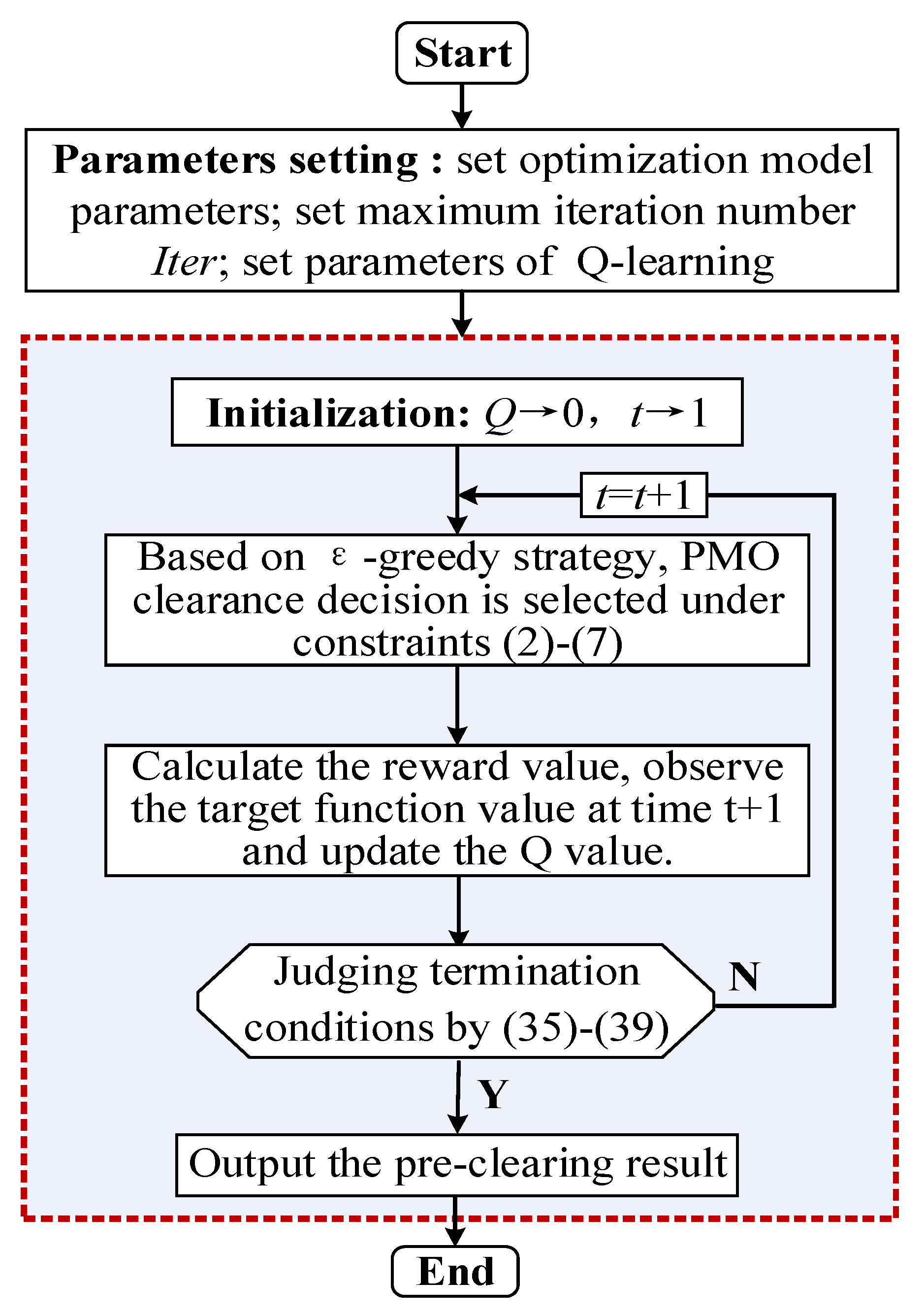
4.2. Model Solving Method of Optimization Clearing Model
5. Case Study
5.1. Basic Parameters
5.2. Simulation Results
5.2.1. Simulation Results of Safety Benefit
5.2.2. Simulation Results of Economic Benefits
| Decrease Amount/CNY Million | Maximum | Minimum Value | Average Value |
|---|---|---|---|
| Big scene | 21.6 | 8.1 | 13.8 |
| Middle scene | 22.4 | 10.1 | 14.9 |
| Small scene | 27.1 | 10.6 | 16.4 |

| Decrease Amount/CNY Million | Maximum Value | Minimum Value | Average Value |
|---|---|---|---|
| Big scene | 26.7 | 12.4 | 18.0 |
| Middle scene | 25.5 | 13.2 | 19.0 |
| Small scene | 24.6 | 14.1 | 19.0 |

| Decrease Amount/CNY Million | Maximum Value | Minimum Value | Average Value |
|---|---|---|---|
| Big scene | 6.7 | 0.7 | 2.9 |
| Middle scene | 4.0 | 1.2 | 2.6 |
| Small scene | 4.4 | 1.4 | 2.6 |

| Decrease Amount/CNY Million | Maximum Value | Minimum Value | Average Value |
|---|---|---|---|
| Big scene | 12.5 | 5.0 | 7.5 |
| Middle scene | 14.1 | 4.2 | 7.8 |
| Small scene | 13.1 | 4.5 | 8.4 |

5.2.3. Simulation Results of Environmental Benefit
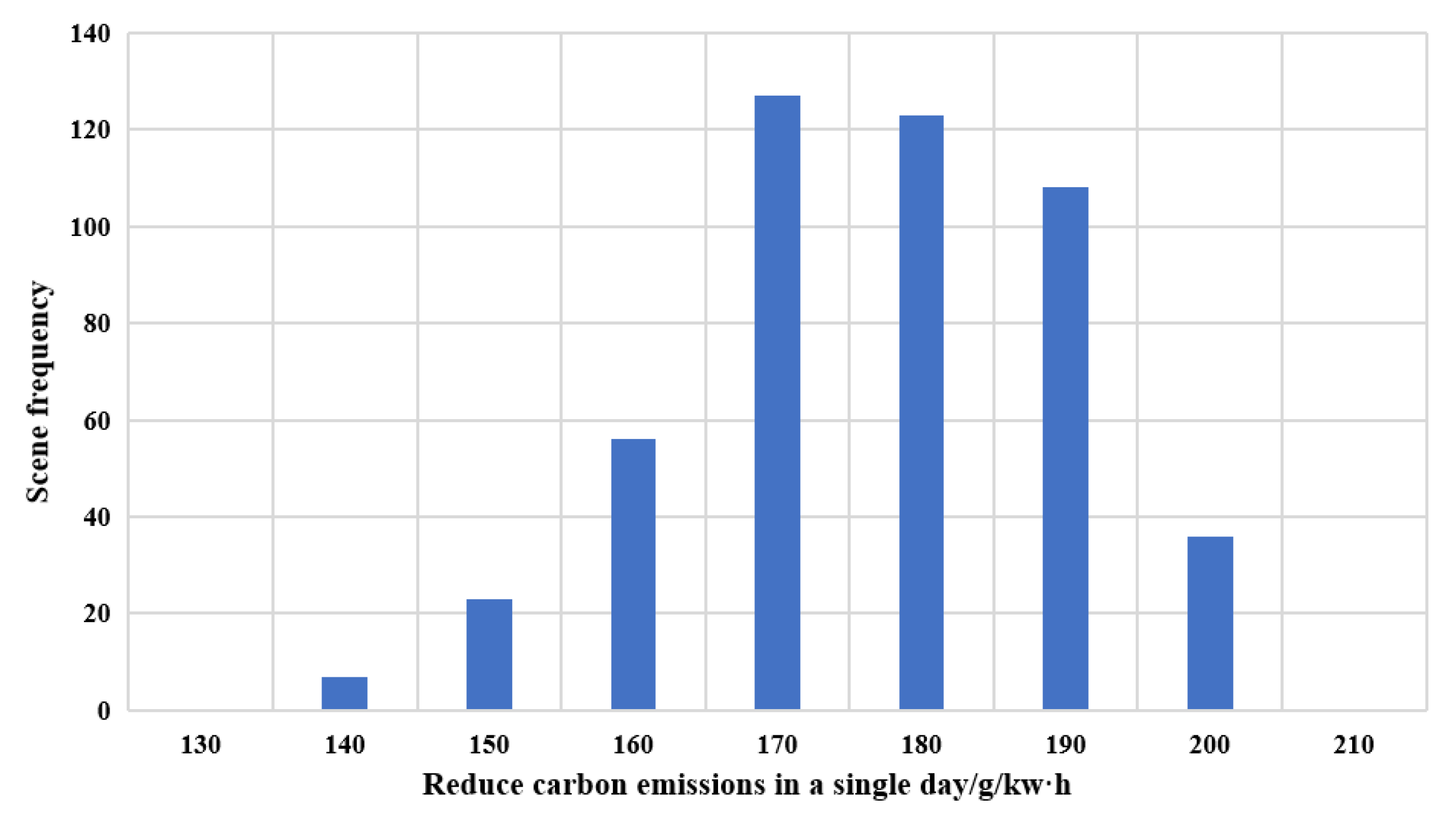
6. Conclusions
Author Contributions
Funding
Data Availability Statement
Conflicts of Interest
Nomenclature
| RESM | regional electricity spot market |
| CFP | coal-fired power |
| PMO | Provincial electricity spot market operator |
| RMO | Regional electricity spot market operator |
| DC | Direct current |
| AC | Alternating current |
| NDRC | National Development and Reform Commission |
| NEA | National Energy Administration |
| The operating cost of the provincial market in the scenario s | |
| The state probability of the scenario s | |
| The total number of scenarios | |
| The number of generators within the province | |
| , | The electricity and reserve capacity biding prices for generator n within the province, MW |
| The operating cost coefficient for the generator n, CNY/MW | |
| , | The clearing power and reserve capacity of the generator n within the province in the scenario s during the time period t, MW |
| The electricity purchased by inter-provincial traders in the inter-provincial market during the time period t, MW | |
| The clearing price of the inter-provincial market during the time period t, CNY/MW | |
| The decision coefficients of switching (startup is 1; shutdown is 0) | |
| The decision coefficients of starting (startup is 1; non-startup is 0) | |
| The decision coefficients of stopping (1 is shutdown; 0 is non-shutdown) | |
| The upper adjustment amount of the unit in section b, MW | |
| The down-regulation quantity of the unit , MW | |
| The down-regulation quotation of the unit , MW | |
| The adjustment quotation in section b, MW | |
| The load demand of electricity users m during the time period t in the scenario s, MW | |
| The standby coefficient of the provincial power grid | |
| The upper limit of the ramp for generator n, MW | |
| The lower limit of the ramp for generator n, MW | |
| , | The upper and lower limits of the output of generator n, MW |
| The power of tie line n, MW | |
| The upper limit of the operation power of tie lines n, MW | |
| The lower limit of the operation power of tie lines n, MW | |
| The decentralized provincial electricity spot market, MW | |
| The number of optimization segments | |
| , | The bidding power for the up/down adjustment of the unit in the segment , MW |
| , | The quotation for the up/down adjustment of the unit in the segment , MW |
| The thermal power unit in the centralized provincial electricity spot market, MW | |
| The number of quotation segments for the unit | |
| Thermal elasticity coefficient of prosumers | |
| The quotation for segment of the unit , MW | |
| The new energy units | |
| The abandoned power of the new energy unit , MW | |
| , | The benchmark and final outputs of thermal power unit in the decentralized provincial electricity spot market at time t, MW |
| , | The maximum and minimum outputs of the unit , MW |
| , | The maximum uphill and downhill climbing rates of the unit , MW/h |
| The output of thermal power unit in the centralized provincial electricity spot market at time t, MW | |
| , | The maximum and minimum outputs of the unit , MW |
| The predicted output of the new energy unit at time t, MW | |
| The biding power in the market, MW | |
| , , | The pumping/generating/final powers of the pumped storage unit at time t, MW |
| , | The state variable for pumping/generating |
| The stored energy of the pumped storage unit at time t, MW | |
| The maximum pumping power, MW | |
| The maximum generating power, MW | |
| , | The maximum/minimum stored energies, MW |
| , | The initial and final stored energy of the pumped storage unit , MW |
| The total system demand at time t, MW | |
| The fixed output unit | |
| The cross-regional transmission line | |
| The maximum transmission capacity of the transmission line, MW | |
| The set of generator units in the province | |
| , | The upper/lower reserved energy constraints for the province , MW |
| , | The regional up/down reserved energies, MW |
| The energy gap of province at time t | |
| , | The uphill/downhill climbing constraints for the energy gap in the province , MW/h |
| The collection of provinces with energy gaps | |
| The set of start–stop action combinations | |
| , | The penalty coefficient of the start–stop time deviation for start and stop actions, CNY/MW |
| The penalty coefficient of the power balance deviation, CNY/MW | |
| The state at time t | |
| The action at time t | |
| The current reward | |
| The future reward | |
| The discount rate, |
References
- Zhang, Y.; Zhang, J.; Yang, Z.; Li, J. Analysis of the distribution and evolution of energy supply and demand centers of gravity in China. Energy Policy 2012, 49, 695–706. [Google Scholar] [CrossRef]
- Liu, J.; Niu, D.; Song, X. The energy supply and demand pattern of China: A review of evolution and sustainable development. Renew. Sustain. Energy Rev. 2013, 25, 220–228. [Google Scholar] [CrossRef]
- Zhang, L.; Sun, Y.; Zhang, Y. Research on mechanism of inter-provincial contract transfer and replacement transaction in South China Electricity Market. Power Syst. Technol. 2012, 36, 262–268. [Google Scholar]
- Xu, Z.; Chen, W.; Ding, J. Optimization path of inte-provincial medium and long-term transaction mechanism in southern China under two-level transaction mode. Electr. Power Autom. Equip. 2022, 42, 175–181. [Google Scholar]
- National Development and Reform Commission Office; National Energy Administration General Office. Notice on Carrying Out Pilot Projects of the Electricity Spot Market Construction. 2017. Available online: https://www.ndrc.gov.cn/xxgk/zcfb/tz/201709/t20170905_962552.html (accessed on 20 January 2024).
- National Development and Reform Commission Office; National Energy Administration General Office. Notice on Further Accelerating the Construction of Electricity Spot Markets. 2023. Available online: https://www.ndrc.gov.cn/xxgk/zcfb/tz/202311/t20231101_1361704.html (accessed on 20 January 2024).
- National Development and Reform Commission and National Energy Administration. Guiding Opinions on Accelerating the Construction of a Unified National Electricity Market System. 2022. Available online: https://www.gov.cn/zhengce/zhengceku/2022-01/30/content_5671296.htm (accessed on 20 January 2024).
- Wu, Z.; Wang, J.; Zhong, H.; Gao, F.; Pu, T.; Tan, C.-W.; Chen, X.; Li, G.; Zhao, H.; Zhou, M.; et al. Sharing economy in local energy markets. J. Mod. Power Syst. Clean Energy 2023, 11, 714–726. [Google Scholar] [CrossRef]
- Ahlqvist, V.; Holmberg, P.; Tangerås, T. A survey comparing centralized and decentralized electricity markets. Energy Strategy Rev. 2022, 40, 100812. [Google Scholar] [CrossRef]
- Song, Y.; Bao, M.; Ding, Y.; Shao, C.; Shang, N. Review of Chinese electricity spot market key issues and its suggestions under the new round of Chinese power system reform. Proc. CSEE 2020, 40, 3172–3187. [Google Scholar]
- Wu, Z.; Wang, J.; Zhou, M.; Xia, Q.; Tan, C.-W.; Li, G. Incentivizing frequency provision of power-to-hydrogen toward grid resiliency enhancement. IEEE Trans. Ind. Inform. 2023, 19, 9370–9381. [Google Scholar] [CrossRef]
- Cao, Y.; Lin, R.; Liu, B.; Meng, Z.; Wetzel, D. Tracking China’s Provincial Spot Market Designs: 2019. Rocky Mountain Institute at. Available online: https://rmi.org/insight/tracking-chinas-provincial-spot-market-designs (accessed on 20 January 2024).
- Davidson, M.R.; P’erez-Arriaga, I. Avoiding pitfalls in China’s electricity sector reforms. Energy 2020, 41, 119–142. [Google Scholar] [CrossRef]
- Yi, Y.; Zhang, L.; Du, L. Cross-regional integration of renewable energy and corporate carbon emissions: Evidence from China’s cross-regional surplus renewable energy spot trading pilot. Energy Econ. 2024, 135, 107649. [Google Scholar] [CrossRef]
- Fatras, N.; Ma, Z.; Duan, H.; Jørgensen, B.N. A systematic review of electricity market liberalisation and its alignment with industrial consumer participation: A comparison between the Nordics and China. Renew. Sustain. Energy Rev. 2022, 167, 112793. [Google Scholar] [CrossRef]
- Cody, H.; Chiara, P.L.; Ashish, R.; Webster, M. Intraday markets, wind integration and uplift payments in a regional U.S. power system. Energy Policy 2023, 175, 113503. [Google Scholar]
- Zhang, Y.; Anvari-Moghaddam, A.; Peyghami, S.; Blaabjerg, F. Novel Frequency Regulation Scenarios Generation Method Serving for Battery Energy Storage System Participating in PJM Market. Energies 2024, 17, 3479. [Google Scholar] [CrossRef]
- Qu, Z.; He, L.; Lu, X.J. A Two-Stage Forecasting Approach for Day-Ahead Electricity Price Based on Improved Wavelet Neural Network with ELM Initialization. IEEE Trans. Ind. Appl. 2024, 60, 5061–5073. [Google Scholar] [CrossRef]
- Chen, H.; Pilong, C.; Patricio, R.; Frogg, D.; Jayachandran, M.; Manno, D.; Sexauer, J.; Callaghan, C.; Dropkin, R.; Mulhern, J.; et al. Grid Resilience with High Renewable Penetration: A PJM Approach. IEEE Trans. Sustain. Energy 2023, 14, 1169–1177. [Google Scholar] [CrossRef]
- Nord Pool. The Market Data in Nordic Pool [EB/OL]. (5 December 2021) [21 November 2022]. Available online: https://www.nordpoolgroup.com/en/search/?query=The+Market+Data+in+Nordic+Pool (accessed on 20 January 2024).
- Nagel, N.O.; Böhringer, C.; Rosendahl, K.E.; Bolkesjø, T.F. Impacts of green deal policies on the Nordic power market. Util. Policy 2023, 80, 101475. [Google Scholar] [CrossRef]
- Liu, S.; Huang, Y.; Wang, Y.; Shao, Q.; Zhou, H.; Wang, J.; Chen, C. Incentive Mechanisms to Integrate More Renewable Energy in Electricity Markets in China. Energies 2023, 16, 6573. [Google Scholar] [CrossRef]
- Jinqi, L.; Jihong, W.; Joel, C. Evolution and reform of UK electricity market. Renew. Sustain. Energy Rev. 2022, 161, 112317. [Google Scholar]
- Bock, J.; Geissel, S. Evolution of stock market efficiency in Europe: Evidence from measuring periods of inefficiency. Financ. Res. Lett. 2024, 62, 105129. [Google Scholar] [CrossRef]
- Micklitz, H. Book Review: Personal Debt in Europe: The EU Financial Market and Consumer Insolvency, by Federico Ferretti and Daniela Vandone; Common Market Law Review; Cambridge University Press: Cambridge, UK, 2023. [Google Scholar]
- Chen, Y.; Zhang, W.; Zhang, C.; Wu, P. Operation mechanism of inter-provincial and intra-provincial spot market for promoting new energy consumption. Autom. Electr. Power Syst. 2021, 45, 104–113. [Google Scholar]
- Ji, P.; Zeng, D.; Sun, T.; Huang, W.; Shen, W. Study on Deepening the Construction of National Unified Electricity Market System—Taking the design of the coupling evolution path of inter-provincial and intra-provincial markets as the breakthrough point. Price Theory Pract. 2022, 2022, 105–109. [Google Scholar]
- Liu, Y.; Jiang, Z.; Guo, B. Assessing China’s provincial electricity spot market pilot operations: Lessons from Guangdong province. Energy Policy 2022, 164, 112917. [Google Scholar] [CrossRef]
- Zhao, X.; Sun, C.; Zhong, Z.; Liu, S.; Yang, Z. Effect of market structure on renewable energy Development—A simulation study of a regional electricity market in China. Renew. Energy 2023, 215, 118911. [Google Scholar] [CrossRef]
- Du, F.; Hu, R.; Liu, Z.; Zhang, X.; Zhang, R. Research on Regional Spot Market Clearing Model Considering Subregional Power Exchange Constraints. J. Phys. Conf. Ser. 2023, 2592, 012069. [Google Scholar] [CrossRef]
- Guan, L.; Chang, J.; Sun, D.; Wang, D.; Huang, G.; Zhang, R.; Zhao, T. Analysis and Thinking on Trial Operation of Inter-provincial Electricity Spot Market. Autom. Electr. Power Syst. 2024, 48, 2–10. [Google Scholar]
- Liu, S.; Cai, B.; Gao, M.; Wu, Y.; Chen, K.; Zhu, X.; He, S. Empirical evidence for the edge of a centralized regional market over a cross-province balancing market in allocating electricity resources: A case study of Yunnan in China. Energy Rep. 2023, 9 (Suppl. S7), 911–921. [Google Scholar] [CrossRef]
- Chen, Y.; Wang, H.; Yan, Z.; Xu, X.; Zeng, D.; Ma, B. A two-phase market clearing framework for inter-provincial electricity trading in Chinese power grids. Sustain. Cities Soc. 2022, 85, 104057. [Google Scholar] [CrossRef]
- Wang, C.; Ni, M.; Shi, Y. Optimizing electricity market Clearing with Segmented Electricity Prices: A Bilevel Model. Sustainability 2023, 15, 13575. [Google Scholar] [CrossRef]
- Liu, X.; Conejo, A.J. Single-Level Electricity Market Equilibrium with Offers and Bids in Energy and Price. IEEE Trans. Power Syst. 2021, 36, 4185–4193. [Google Scholar] [CrossRef]
- Zhang, L.; Chen, H.; Huang, X.; Qiao, N.; Zhang, C. The design logic of European electricity balance market mechanism and its enlightenment to the development planning of auxiliary service market under the goal of carbon neutrality in China. Proc. CSEE 2023, 43 (Suppl. S1), 14–30. [Google Scholar]
- Zhang, L. Thoughts on the Construction of China electricity market System under the New Situation. China Power Enterp. Manag. 2022, 4, 20–25. [Google Scholar]
- Zhang, H.; Hun, H.; Zhang, L. Framework design of regional power grid security check mechanism in complex market environment. China Electr. Power 2021, 54, 11–18. [Google Scholar]
- Liu, Z.; Zhao, S.; Luo, X.; Huang, Y.; Gu, R.; Li, J.; Li, L. Two-layer energy dispatching and collaborative optimization of regional integrated energy system considering stakeholders game and flexible load management. Appl. Energy 2025, 379, 124918. [Google Scholar] [CrossRef]
- Apel, C.; Ozan, K. Risk-averse optimal bidding strategy considering bi-level approach for a renewable energy portfolio manager including EV parking lots for imbalance mitigation. Sustain. Energy Grids Netw. 2021, 28, 100539. [Google Scholar]
- Wu, J.; Wang, J.; Kong, X. Strategic bidding in a competitive electricity market: An intelligent method using Multi-Agent Transfer Learning based on reinforcement learning. Energy 2022, 256, 124657. [Google Scholar] [CrossRef]
- Paudel, D.; Das, K. A deep reinforcement learning approach for power management of battery-assisted fast-charging EV hubs participating in day-ahead and real-time electricity markets. Energy 2023, 283, 129097. [Google Scholar] [CrossRef]
- Harrold, D.; Cao, J.; Fan, Z. Renewable energy integration and microgrid energy trading using multi-agent deep reinforcement learning. Appl. Energy 2022, 318, 119151. [Google Scholar] [CrossRef]
- Lu, R.; Hong, S.H.; Zhang, X. A Dynamic pricing demand response algorithm for smart grid: Reinforcement learning approach. Appl. Energy 2018, 220, 220–230. [Google Scholar] [CrossRef]
- Chen, H. Research on Optimal Dispatching Method of Power and Energy System with 0–1 Variables. Ph.D. Thesis, South China University of Technology, Guangzhou, China, 2019. [Google Scholar]
- New Energy Cloud of State Grid Corporation of China. Data Set of Installed Capacity of Provinces in East China. Available online: https://sgnec.sgcc.com.cn/ (accessed on 20 January 2024).
- National Development and Reform Commission Office. Typical Power Load Curves of Provincial Power Grids in China. 2020. Available online: https://www.ndrc.gov.cn/xwdt/tzgg/202012/P020201202546044875868.pdf (accessed on 20 January 2024).
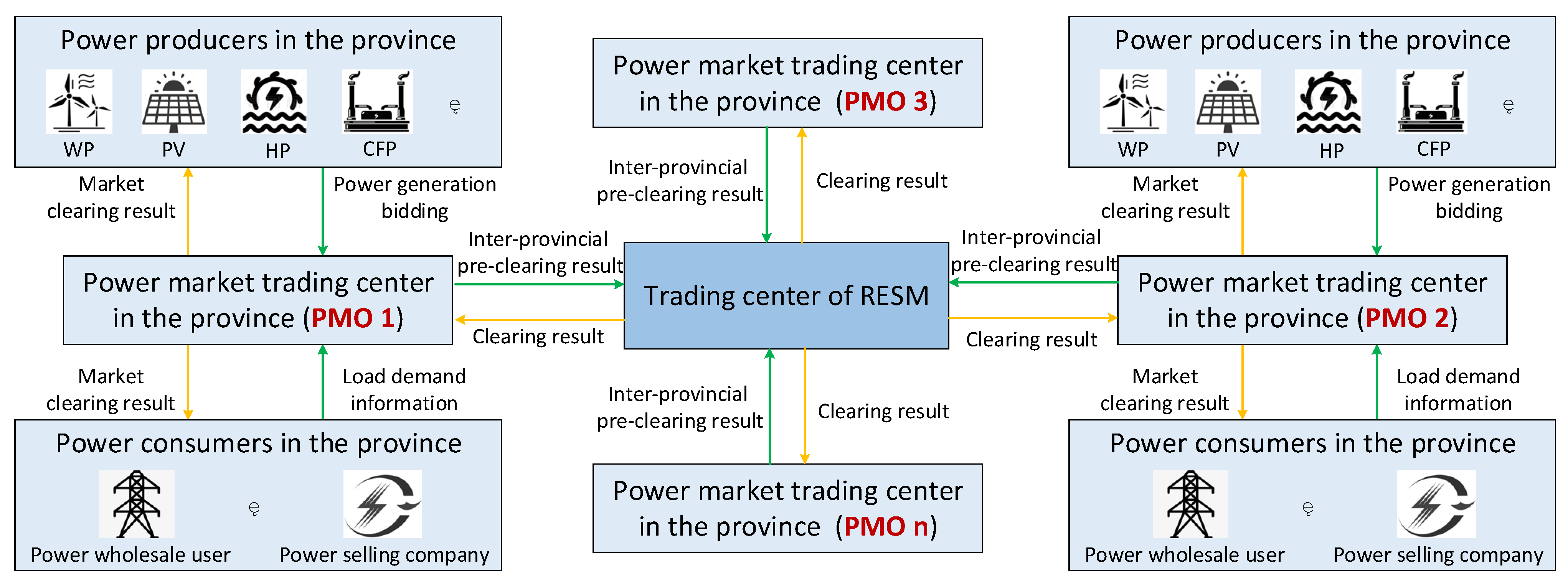
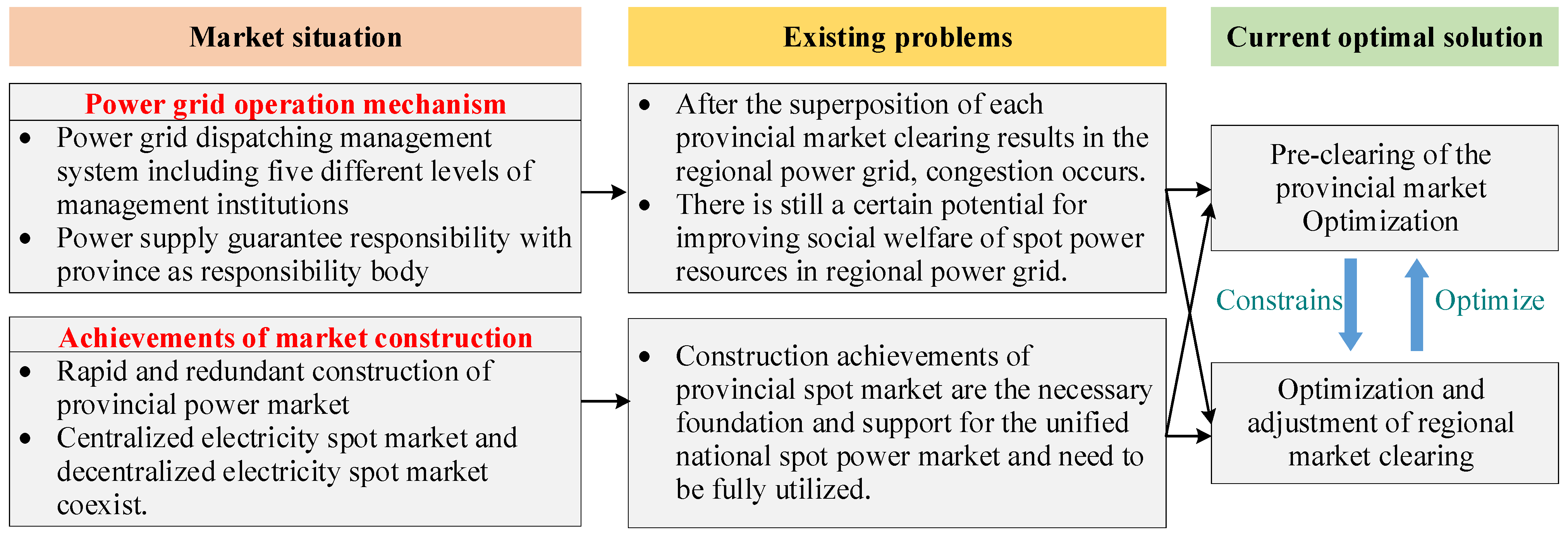


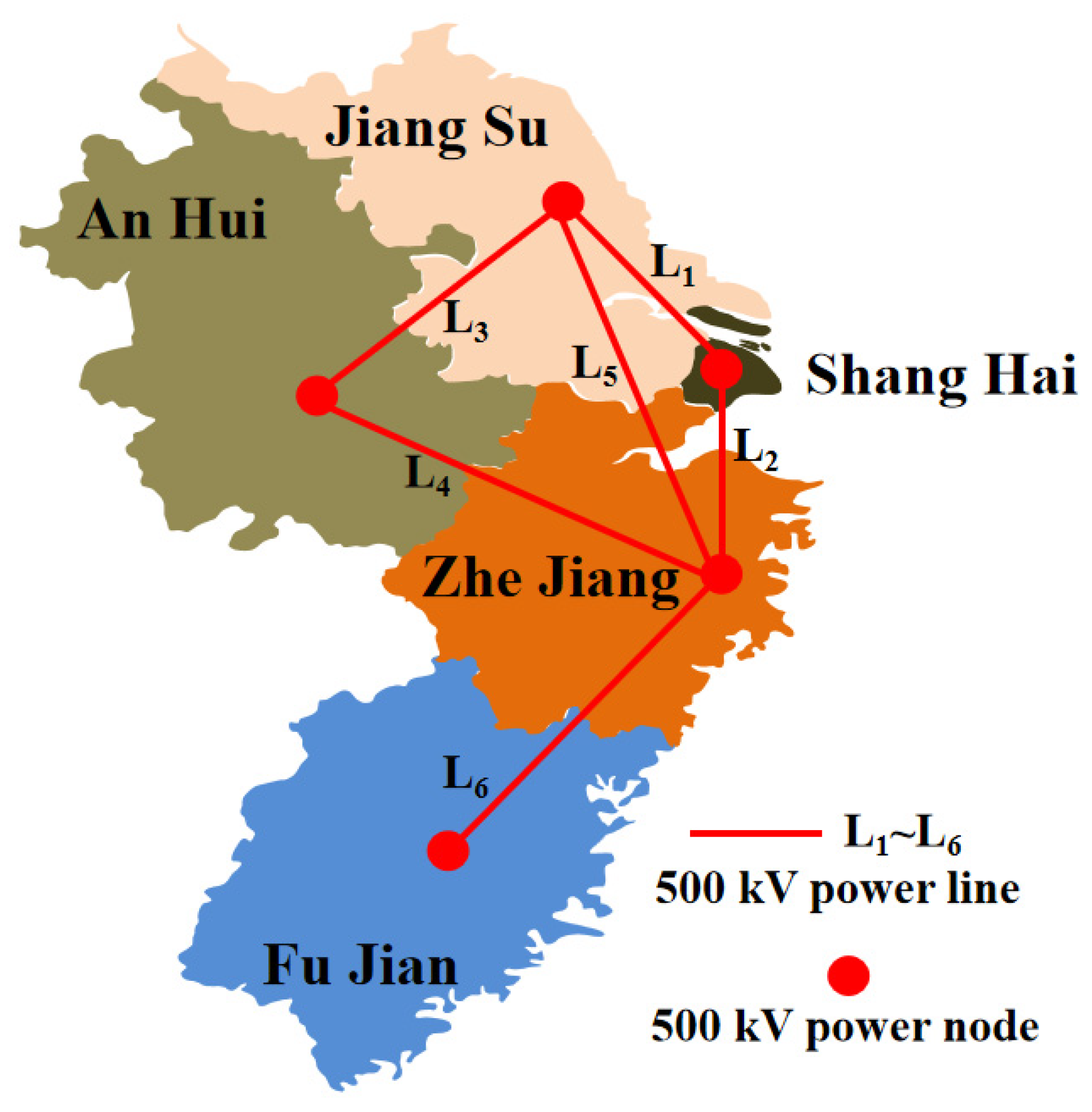

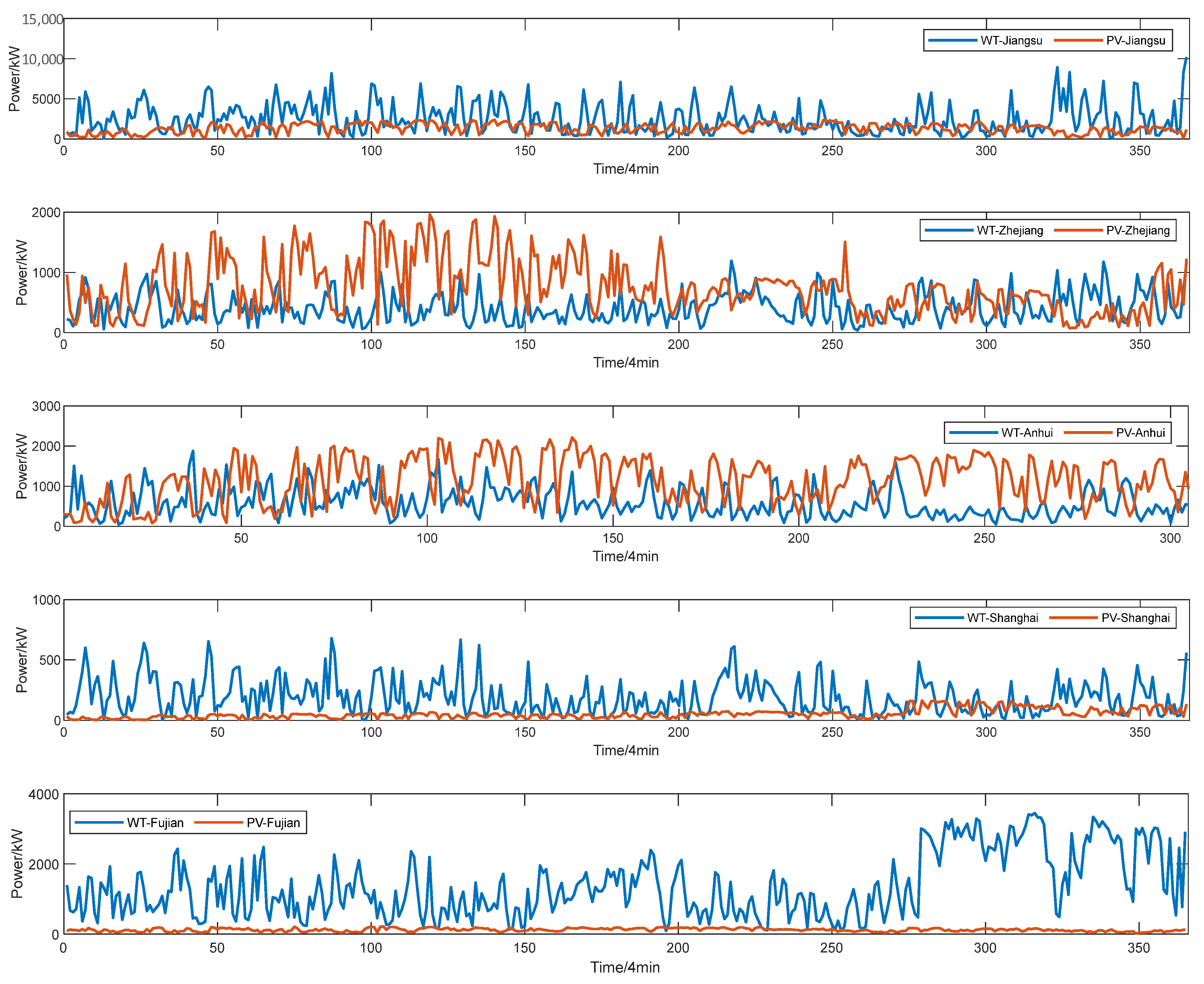
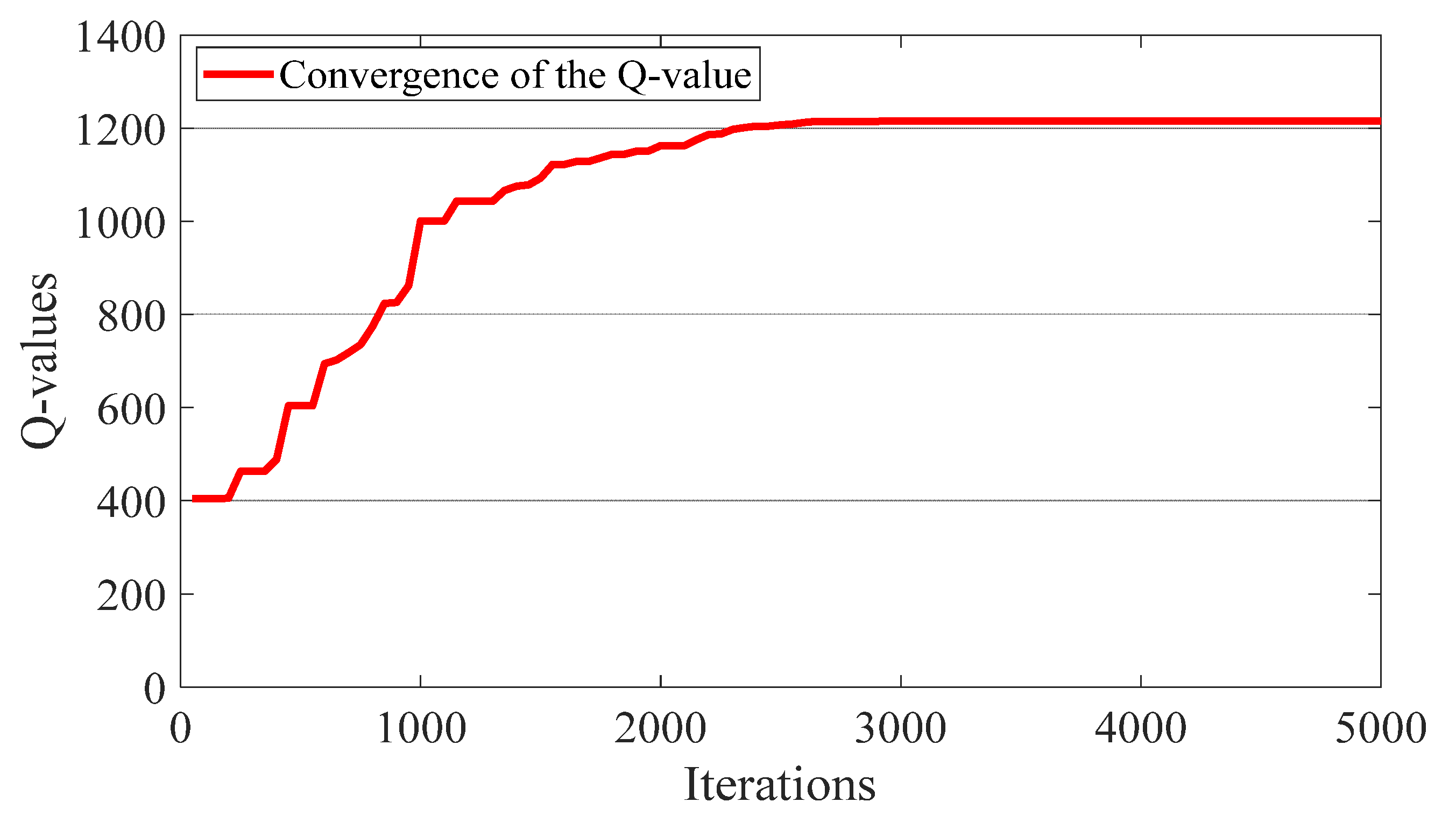
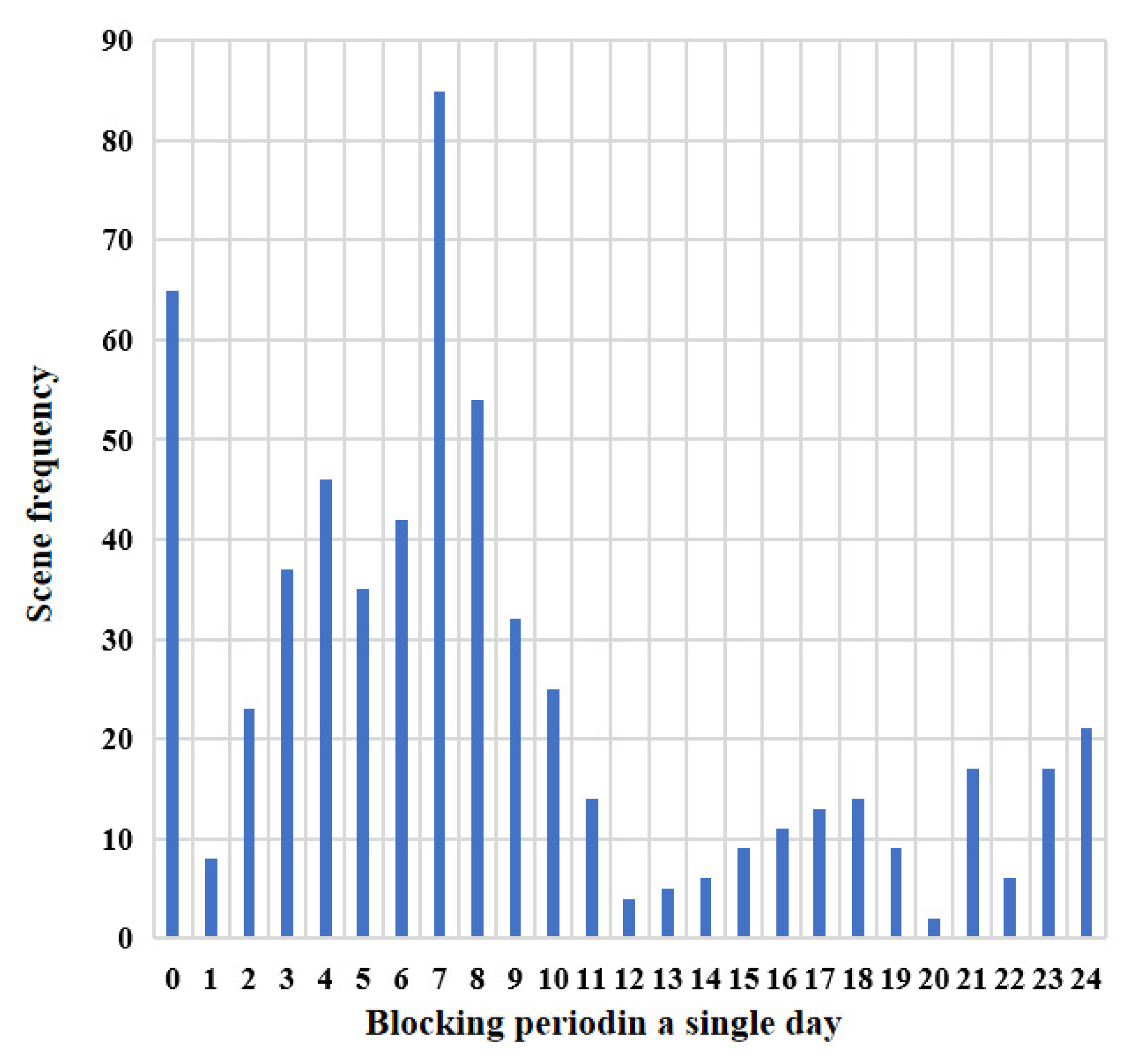

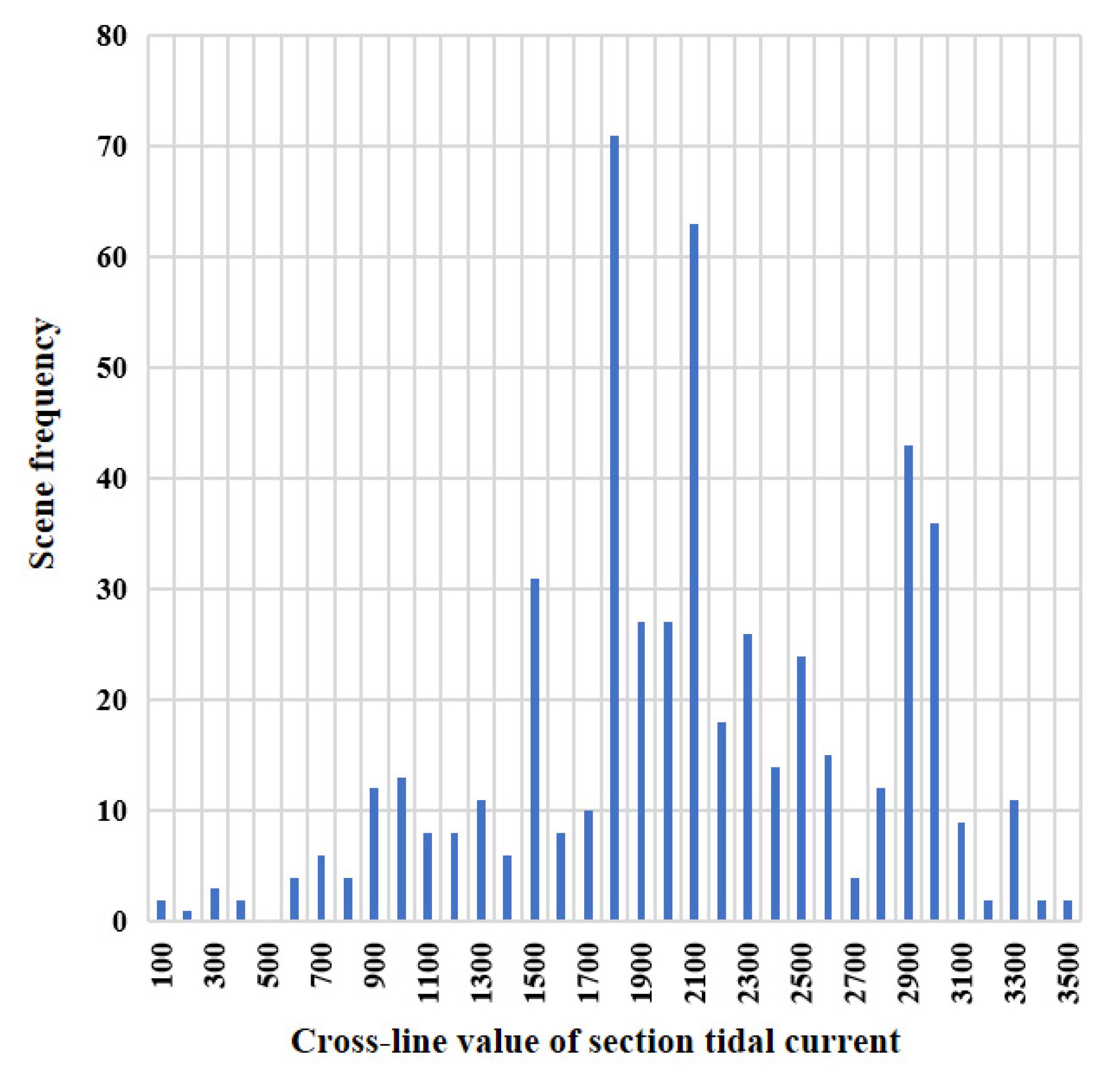
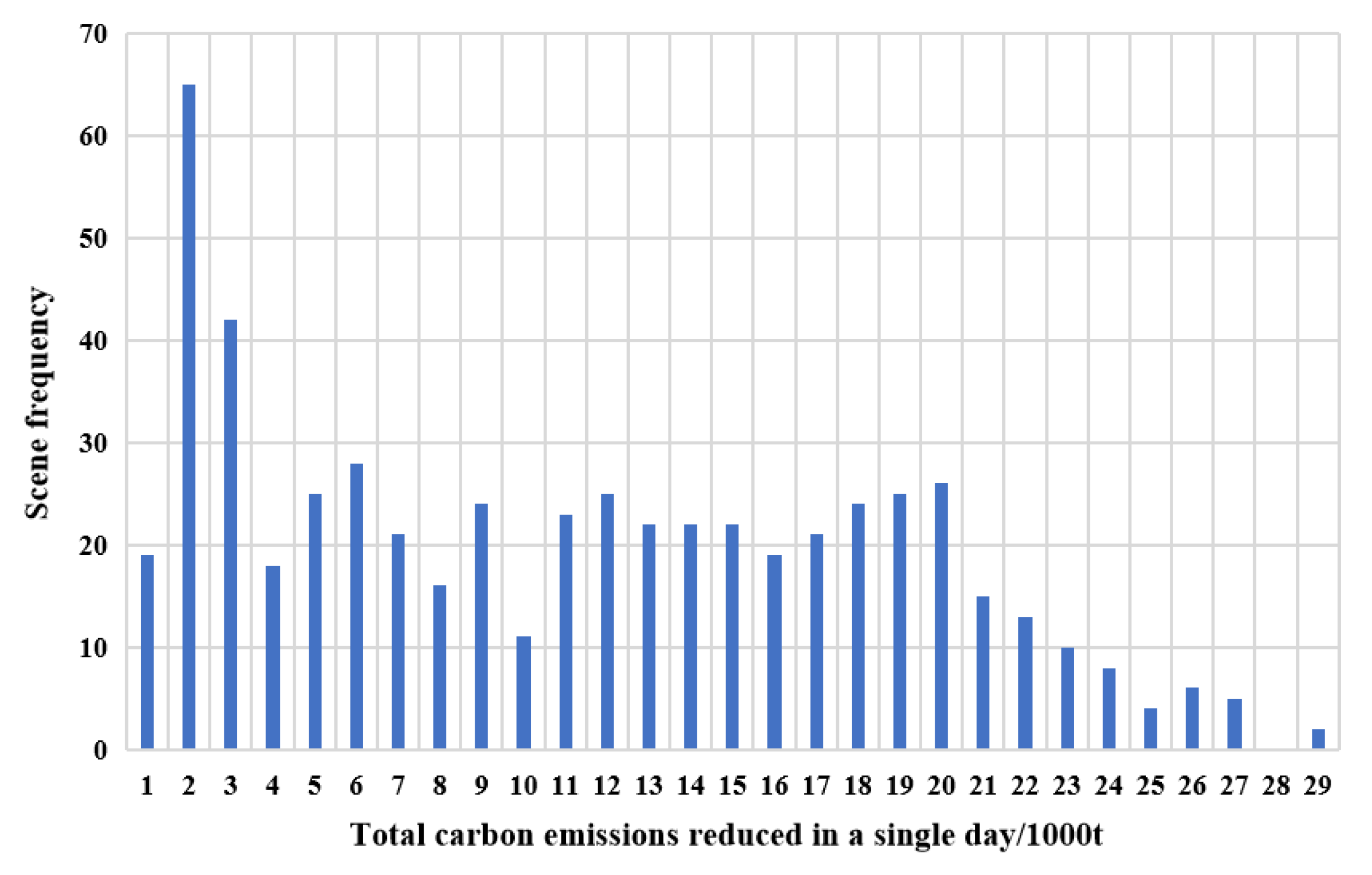
| Region | Power Supply Installation/MW |
|---|---|
| Jiang Su | 14,147 |
| Zhe Jiang | 10,135 |
| An Hui | 7821 |
| Shang Hai | 2669 |
| Fu Jian | 6372 |
Disclaimer/Publisher’s Note: The statements, opinions and data contained in all publications are solely those of the individual author(s) and contributor(s) and not of MDPI and/or the editor(s). MDPI and/or the editor(s) disclaim responsibility for any injury to people or property resulting from any ideas, methods, instructions or products referred to in the content. |
© 2025 by the authors. Licensee MDPI, Basel, Switzerland. This article is an open access article distributed under the terms and conditions of the Creative Commons Attribution (CC BY) license (https://creativecommons.org/licenses/by/4.0/).
Share and Cite
Li, Y.; Zhang, L.; Cong, Y.; Chen, H.; Zhang, F. Designing a Clearing Model for the Regional Electricity Spot Market Based on the Construction of the Provincial Electricity Market: A Case Study of the Yangtze River Delta Regional Electricity Market in China. Processes 2025, 13, 492. https://doi.org/10.3390/pr13020492
Li Y, Zhang L, Cong Y, Chen H, Zhang F. Designing a Clearing Model for the Regional Electricity Spot Market Based on the Construction of the Provincial Electricity Market: A Case Study of the Yangtze River Delta Regional Electricity Market in China. Processes. 2025; 13(2):492. https://doi.org/10.3390/pr13020492
Chicago/Turabian StyleLi, Yunjian, Lizi Zhang, Ye Cong, Haoxuan Chen, and Fuao Zhang. 2025. "Designing a Clearing Model for the Regional Electricity Spot Market Based on the Construction of the Provincial Electricity Market: A Case Study of the Yangtze River Delta Regional Electricity Market in China" Processes 13, no. 2: 492. https://doi.org/10.3390/pr13020492
APA StyleLi, Y., Zhang, L., Cong, Y., Chen, H., & Zhang, F. (2025). Designing a Clearing Model for the Regional Electricity Spot Market Based on the Construction of the Provincial Electricity Market: A Case Study of the Yangtze River Delta Regional Electricity Market in China. Processes, 13(2), 492. https://doi.org/10.3390/pr13020492





